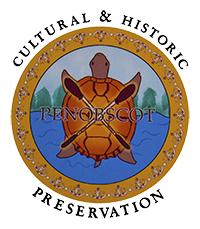
Population: 2,398
Territory
Ancestral Territory – Our land base today is only a fraction of a fraction of what our ancestor occupied. Our ancestral territory included many rivers
that flow into the Gulf of Maine. These include all the watersheds from the Machias River in the east, to Cape Ann in Massachusetts.Reservation Land
Islands System- 4840.88 acres
Matagamon Reservation – 24 acres
Smith Island – 1 acre
Trust Land – 86,357.52 acres
Fee Land – 28,004.80 acres
Tribal Government:
Penobscot Nation is one of the oldest continuously operating governments in the world.
Tribal Chief – The citizens of the Penobscot Nation elect a Chief every four (4) years. There are no term limits for Chiefs. Our current Chief is Kirk E. Francis Sr.
Vice Chief – The citizens of the Penobscot Nation elect the Sub Chief also. However, they are not elected as a pair like U.S. Presidential elections. Terms are also four (4) years, with no term limits. Our current Vice Chief is Mark Sockbeson.
Tribal Government - The Penobscot Nation has a twelve (12) member tribal council. The term for council members are four (4) years. However, elections for council are held every two years. Half the council seats are up for re-election every two (2) years. This ensures that the Penobscot Nation has at least six (6) senior council members, and never an entirely new council.Council Members
Ronald Bear
Pamela Cunningham
Robert Dana
Cheryl Francis
Lee Ann Francis
Miles Francis
Yvonne Francis-Ferland
Donna Loring
John Neptune
Elizabeth Sockbeson
Charlene Virgilio
Penobscot Representative – The Penobscot Legislative Representatives in the Maine Legislature is an elected position. The citizens of the Penobscot Nation elect a Representative every four (4) years with no term limits. Our current Legislative Representative is Wayne Mitchell.
Tribal Infrastructure:
The Penobscot Nation employs approximately 150 people, the largest employer of Penobscot Citizens, and the third largest employer in the region.
The Penobscot Nation Administration has many departments and programs.
Chiefs Office and CouncilCultural and Historic Preservation Department
Penobscot Language
Museum
Department of Human Services
Child and Family Services
Children and Elder Services
Elder Nutrition and Support
Heating and Electricity Assistance Program
Penobscot Nation Child Daycare
Senior Meal Center
Department of Natural Resources
Air Quality
Conservation Law Enforcement
Fisheries
Forestry
GIS
Water Quality
Wildlife
Education and Career Services
Adult Vocational Training
Bingo Scholarship
High Education Grant Program
Learning Center
Penobscot Fellowship
Eunice Baumann Assisted Living CenterGrants and ContractsHousing DepartmentHuman Resources/PersonnelIV-D Child Support EnforcementLegal DepartmentMaintenance/Public WorksOffice of Violence Against WomenPenboscot Nation Youth ProgramPenobscot High Stakes BingoPenobscot Indian Nation Enterprises (P.I.N.E.)Penobscot Nation FinancePenobscot Nation Health Department
Dental
Medical
Counseling
Fitness Center
Pharmacy
Contract Health Services
Penobscot Nation Information TechnologiesPublic Safety
Fire
Police
Search and Rescue
Tribal ClerkTribal CourtTribal Historic Preservation OfficerTrust Services
Census
Genealogy Research
Real Estate Services
Right Protection
Water Treatment Plant
Confederation:
The Penobscot Nation has belonged to a few confederations in our history. When Europeans arrived the confederation of tribes was known as Mawooshen. Later the Penobscot, Passamaquoddy, Micmac, and Maliseets where confederated with Mohawks and other tribes at Caughnawaga until the 1860’s. This confederation numbered 17 tribes in the Northeastern United States and Eastern Canada. Today the Penobscot, Passamaquoddy, Micmac, and Maliseet are known as the Wabanaki Confederacy.
Indian Island School:
Indian Island School is a Bureau of Indian Affairs (BIA) Grant School located on an island in the Penobscot River near Old Town, Maine, approximately 14 miles north of Bangor, Maine. The current structure has been in operation since 1986. The school is accredited by the State of Maine for Early Childhood through Grade 8. Indian Island School is one of three Native American Schools which comprise the Maine Indian Education School System. The other two schools are Indian Township and Beatrice Rafferty. The School Committee is a five-member board, of which each member is a tribal member. The school's programs are administered by a superintendent and a principal.
Indian Island School, in its pursuit of excellence in education, strives to continuously upgrade the quality of educational opportunities provided to all its students. With effective collaboration among home, school, and community partnerships, Indian Island School is preparing for growth and change through instruction, leadership, staff development assessment, and technology. This growth and change will be enhanced by maintaining and incorporating the rich Penobscot heritage in what we do.
St. Anne’s Church:
Founded in 1688 by Father Louis-Pierre Thury Saint Anne’s- Indian Island is the oldest continuous site of Catholic worship in New England and our present church building is the third oldest Catholic Church in Maine. The church is on the National Registry for Historic Places.
Traditional Sketch:
Language – Traditional language is Penobscot, an Abenaki language in the Algonkian language group.Housing – Traditional house was the bark wigwam. Larger villages may have had longhouses. These homes where typically made from birch or cedar bark.Traditionally are a hunter/gatherer society relying on sophisticated seasonally movement to gather and hunt.“Riverine” Culture – used rivers, lakes, ponds, and streams for transportation.Kinship Based Social Structure – Seasonal movement required families to occupy familial hunting and gathering territories. These groups of families relied on leadership from within. Penobscot were Matrilineal and married couple would live with the bride’s family.Traditional Art:
Brown Ash Basketry
Root Clubs
Birch bark containers and etching
